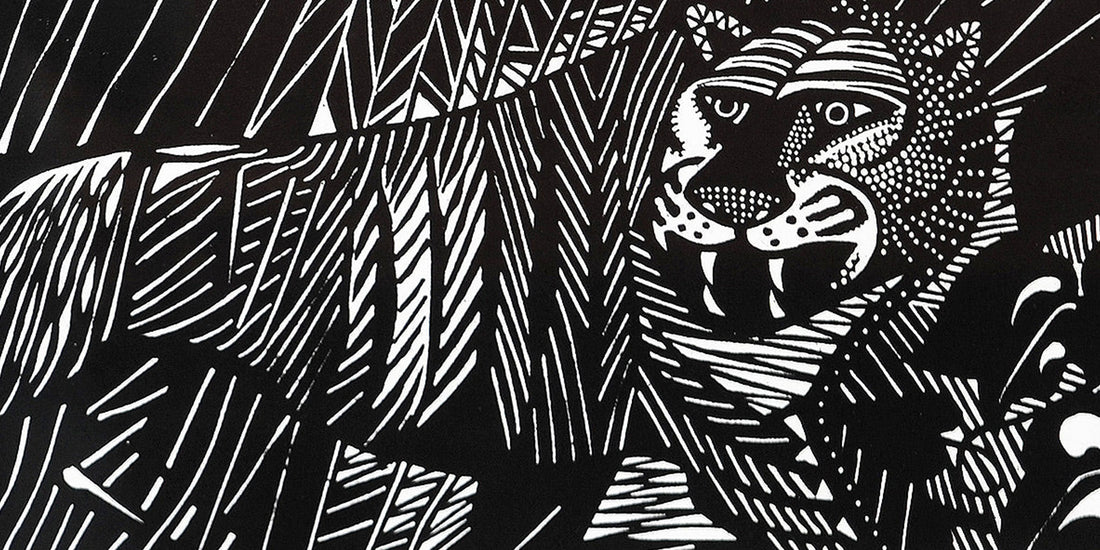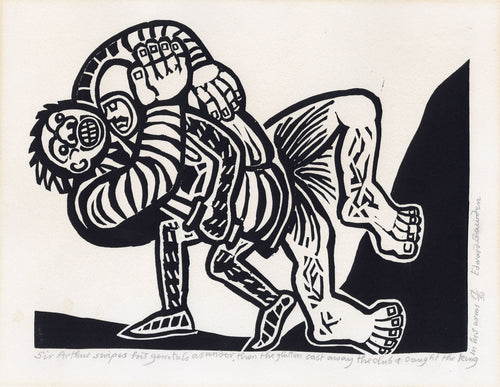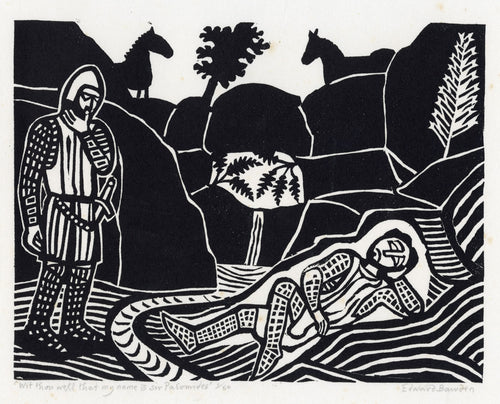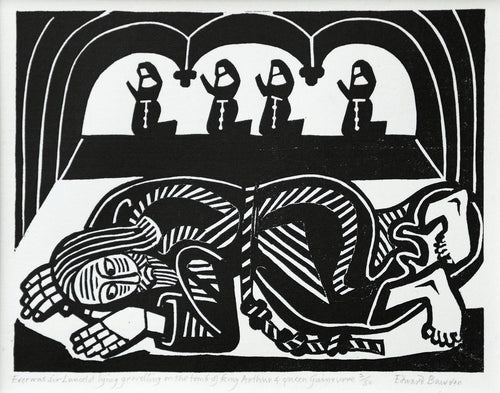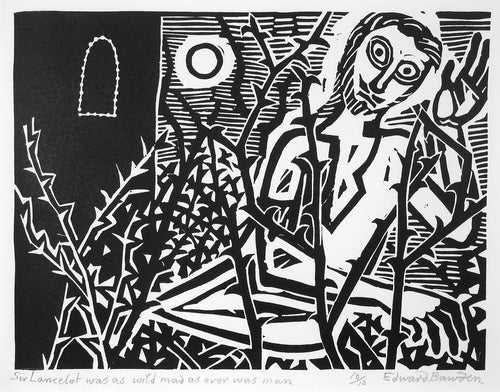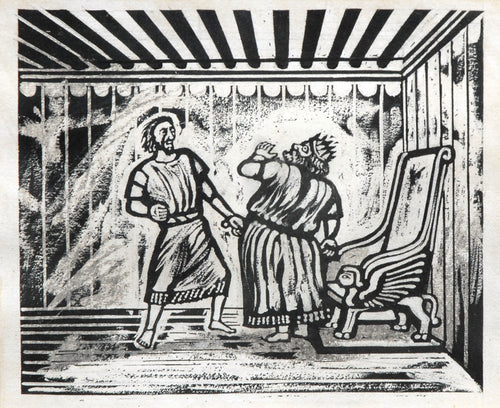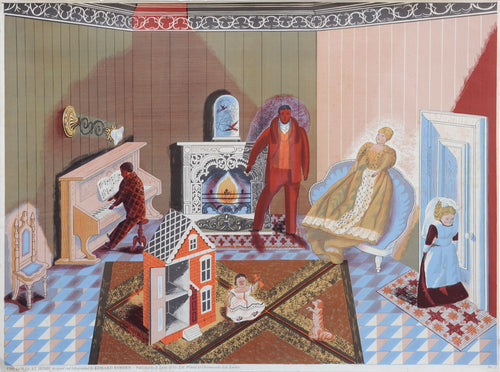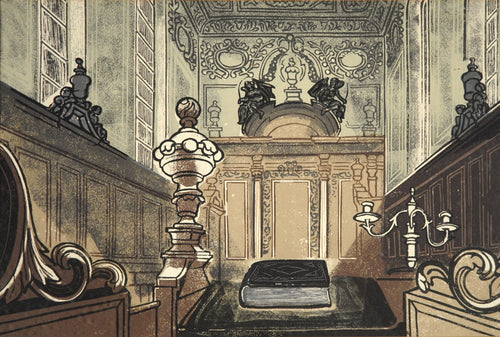Edward Bawden can be considered something of a polymath in the artistic world. Unlike contemporaries of his who were easily pigeonholed, his aptitude for printmaking, illustration, watercolours, murals and commercial design (ranging from advertising to metal garden furniture) has made it difficult for critics to classify him in one of the many 20th century artistic movements and genres.

 (above) Edward Bawden (left) with watercolour of Booton Church; (below) 'Daw in Borrowed Feathers'
(above) Edward Bawden (left) with watercolour of Booton Church; (below) 'Daw in Borrowed Feathers'
Born in 1903 in Braintree, Essex, Bawden was a precocious artist even as a teenager. At the age of 15, Bawden’s headmaster agreed with his parents that he be allowed to spend one school day per week attending classes at the School of Art in Cambridge; just a year later, he was a full-time student there alongside only half-a-dozen others. Soon after he received a coveted Royal Exhibition Scholarship to the Royal College of Art and even began accepting commissions from the Curwen Press and London Transport during his studies.
 'Braintree Cattle Market', produced for the Contemporary Lithographs Ltd. series in 1937
'Braintree Cattle Market', produced for the Contemporary Lithographs Ltd. series in 1937
Commercial graphics - advertising, posters, and industry illustrations - became the bread and butter of Bawden's early career, his designs demonstrating a natural understanding for the visual simplicity required by his clients, as well as his own considerable individual flare.
His use of line - thick, bold and direct - was decidedly modern, and led to line-drawings, linocuts and book illustrations produced in these early years that must have numbered in the thousands. Though at the time these graphic commissions represented employment, financial security, and the mere paying of bills, many have survived to this day and are now the images for which he is best remembered.

 (above) 'Brighton Pier'; (below) 'The Dolls at Home', produced for the Lyons Lithographs First Series
(above) 'Brighton Pier'; (below) 'The Dolls at Home', produced for the Lyons Lithographs First Series
Bawden's first major success was shared in collaboration with life-long friend Eric Ravilious. Both artists had studied as contemporaries at the Royal College, Bawden a hardworking, focused, and resolute student, Ravilious something of a devil-may-care charmer, and both had worked together before, producing a series of black and white illustrations for the London Underground in the early 1920s.
Coming together again, the pair of young artists designed a mural for the Morley Working Men’s College refectory in Lambeth in 1928, unveiled two years later by then Prime Minister Stanley Baldwin. Deemed a great success by all involved, the project heralded the rise of the two up-and-coming designers who would dominate the world of British illustration and graphic design in the late 1920s and '30s.

 (above) Fyfield Church, gouache, pen, and ink; (below) 'Dunkirk', a later print based on Bawden's early wartime experiences in France
(above) Fyfield Church, gouache, pen, and ink; (below) 'Dunkirk', a later print based on Bawden's early wartime experiences in France
Bawden’s success continued throughout the following decade, producing work for London Transport and the hugely successful 'you can be sure of Shell' advertising campaign. One of the very first young men appointed as an Official War Artist, in 1940 he was sent to join fellow artists Edward Ardizzone and Barnett Freedman in France. After being evacuated during fighting in Dunkirk, Bawden was shipped off to the Middle East where he would remain throughout the duration of the conflict.
The Middle East was to have an enormous impact on Bawden's artistic development, and in particular his draughtsmanship. As a student, he had been accepted at the Royal College as a member of the Design School, where young artists operated uninterrupted by the strict figure drawing sessions with which aspiring painters were frequently tasked. Though an innately talented designer, his comparatively ordinary drawing skills had received little comment from his tutors.

 (above) two pen and ink sketches from 1960 demonstrating the evolution in Bawden's draughtsmanship: 'Hermitage of S. Brás, Portugal' (top) and 'Sao Martinho do Porto' (bottom)
(above) two pen and ink sketches from 1960 demonstrating the evolution in Bawden's draughtsmanship: 'Hermitage of S. Brás, Portugal' (top) and 'Sao Martinho do Porto' (bottom)
But during time spent on the move between Ethiopia, Egypt, Libya, Syria and Saudi Arabia, Bawden found the opportunity for his own life classes, sketching portraits of Sheikh hosts, military parades, tent camps and mountain passes as his drawings grew in confidence. Previously, he had been known for his unfussy graphic style; with his emergence from the war, his looser, more romantic draughtsmanship was brought to the fore.

 (above) 'Suddenly departed his Soul...', from Bawden's illustrations of Thomas Malory's 'Chronicles of King Arthur'; (bottom) two woodcut illustrations to Arthur Conan-Doyle's 'The Hound of the Baskervilles'
(above) 'Suddenly departed his Soul...', from Bawden's illustrations of Thomas Malory's 'Chronicles of King Arthur'; (bottom) two woodcut illustrations to Arthur Conan-Doyle's 'The Hound of the Baskervilles'
After Bawden had been relieved of his duties, he continued to consolidate his artistic reputation, producing a large body of prints, book illustrations, film posters, catalogues and murals for another 10 years. In 1957 he attained full Royal Academician status as a Draughtsman, the first ever artist to have been accepted in this special category.
Bawden's output was remarkable not just for its sheer breadth and volume, but above all for its originality. A keen proponent of unloved media, such as the neglected linocut (in which Bawden was a born master), and with an unfaltering sense of his own style despite the influence of artists like Paul Nash and Aubrey Beardsley, his work remains as distinctive now as it did when it first took critics and publishers by surprise in the early 1920s. As Bawden's contemporary and biographer Douglas Percy Bliss once noted, Bawden is not like anybody else.

 (above) the rare lithograph 'Liverpool Street Station'; (below) two original watercolours by Bawden
(above) the rare lithograph 'Liverpool Street Station'; (below) two original watercolours by Bawden
As technology and huge social change gave birth to rapidly shifting artistic philosophies in the post-war period, however, subsequent demand for Bawden's work, derisively labelled as 'illustrative', diminished significantly. This decline, coupled with the death of his wife in 1970, meant that Bawden's output became ever smaller and smaller, and it wasn’t until 1988, when the Kent Institute of Art and Design at Canterbury asked him to put on an exhibition, that (at the age of 84) he re-entered the public arena.
In September of 1989 Bawden was accorded a final, major retrospective exhibition at the Victoria and Albert Museum, an honour shared with few other artists. Though too ill to attend after having suffered a series of multiple strokes, he revelled in the admiration of the national reviews and the bouquets that followed.

 (above) two British monarch linocuts; (below) 'Trinity College Chapel Interior'
(above) two British monarch linocuts; (below) 'Trinity College Chapel Interior'
Bawden died a happy man later that same year. His incredible body of work, which includes famed illustrations for Conan-Doyle's The Hound of the Baskervilles, numerous wartime drawings and paintings, a plethora of advertisements for such famed clients as Fortnum and Mason and Twinings, and a host of iconic prints and posters, has been increasingly admired in recent years for its warmth, wit and directness.
